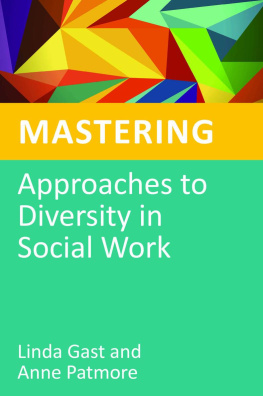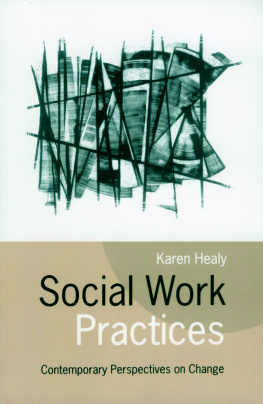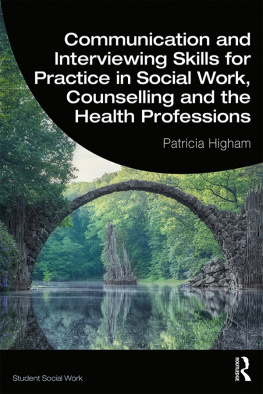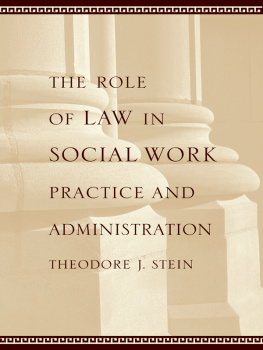INTRODUCTION
Mary McColgan
Inevitably, the challenge of writing a book about relationships has its genesis in gathering the different perspectives of all the contributors, sharing a common vision about why the book is important, establishing common ground about how the work will be approached and embarking on a journey. The production of this book has reflected this journey because the process of writing and editing has mirrored the reality of building relationships: exploring different professional perspectives, responding to unexpected life challenges, supporting each other and, significantly, coming to terms with the untimely death of our esteemed colleague John McLaughlin. The common denominator for us all was our conviction that building relationships lay at the heart of our work as practitioners and educators and was reflected in our practice with service users, students, colleagues and other professionals, but at the same time articulating how central relationship-building was conflicted with the reality of the challenges faced in working in organisations, teams and in a context of economic austerity and rationing of resources.
The unique aspect of this book is its combined academic and practice emphasis with the blended approach of expertise. This book aims to explore a positive approach to learning and development, highlighting the importance of re-establishing that relationship-based social work and caring is fundamental to best practice. Contemporary studies about service provision in the context of families, children and older people (Hood et al. 2016; Ward and Barnes 2016) endorse the significance of relationships as the basis for effective practice.
This book will add to the current published literature of the growing body of professionals and academics promoting relationship-based practice such as Trevithick, Hennessey, Cooper, Megele, Winter and Ruch. We would like to bring the voice of the service user to the forefront and it offers practitioners a 4 Stage Relationship Model underpinned by evidence and theory specific to the relationship-building process which is unique and can be easily applied to practice.
The book will give consideration to the challenges posed by working within a context of austerity and structural inequalities such as poverty, discrimination and political and economic tensions for service delivery. Relationships and communication are the foundation of good social work practice highlighted in the national and international literature. However, social work practice is coming under increased scrutiny in the current socio-political climate. It is crucial that the book takes cognisance of this but it will offer the reader a reassuring and refreshing approach to practice.
The model of building relationships in social work outlined in informs each of the chapters and explains why the relationship is important at each phase of the social work process. The approach is underpinned with knowledge of motivational interviewing techniques, strengths-focused practice resilience, emotional intelligence and empowerment. The model is to some extent mirroring the social work process of engagement, assessment, intervention and evaluation/termination.
This book will be informative and practical for a broad range of readers, from social work students to practitioners and professionals. Its aim is to cover a wide range of themes under the umbrella of relationships experienced within the social work context. This will offer a practical guide and will help navigate the complex interaction and subtle issues that arise through the relationship-building process. The first chapter gives an overview of relationship-based practice and introduces the model. defines the broader historical, social and political landscape which has shaped the backdrop for relationship-based practice. McLaughlin contends that, although the commitment to relationship-based practice has been subordinated to the interests of neoliberalism and managerialism, research evidence supports the centrality of relationships in work with vulnerable adults and their carers. In extrapolating the argument for the benefits of relationship-based work, McLaughlin advocates a holistic approach as the basis for empowering service users and carers.
In , when Le Chile Mentoring and Youth Justice Support Services examine how consistent relationships have a positive impact on the educational attainment and mental health of young people. They focus on the engagement phase, highlighting the important role of the mentor in providing consistency in the relationship and encouraging us not to underestimate the power and positive influence of time-limited relationships.
In Todd applies the model to relationship practice with older adults in a thought-provoking example which highlights many of the ethical and professional challenges in working with end-of-life issues. Through the powerful voice of the service user, key issues such as the right to self-determination and right to choose emerge in a context where a medical model of service delivery predominates. The reader is helped to understand how the social worker uses professional skills to protect the rights of the service user to be an expert by experience and in doing so validates the service user. This example also illustrates how professional values can be evidenced.
Clarke reinforces the concept of empowerment in when he considers how the Relationship Model can be applied in the context of mental health services and significantly within a recovery ethos. Although he does not avoid examining the major challenges of stigma and biomedical approaches, his application of the model is firmly rooted in promoting person-centred care within a predominately medicalised approach. Two aspects which he opines, (1) the benefits of practitioner self-disclosure and (2) co-production and reparative relationships, support the recognition of service users as equal partners.
Interestingly, not only bring the Relationship Model to life but also offer detailed guidance about how recognition and validation are achieved through skilled intervention and professional values.
Attachment is one concept which underpins relationship-building and this is explored in different ways through . Connor et al. address the components of building relationships in the context of group care settings. They highlight the importance of understanding how attachment is the foundation of key relationships and how several models of care in the United Kingdom are underpinned by this ethos. The practice example conveys important factors that contribute to relationship-building: environment, attitudes, values and verbal and nonverbal communication. Equally self-awareness and self-knowledge contribute to social workers capacity to be receptive to the needs of others.
MacDermott and McCall address the important supervisory relationship within practice learning in . Again this is another unique aspect of the book, as we explore how relationship-based practice can be applied to professional learning and development. Emphasising the role of the personal narrative as well as attachment concepts, the process of transformative learning is defined using the Relationship Model. In this way the reader is helped to understand how effective learning involves a complex interplay between personal dimensions, reflective practice and a relationship which promotes trust.








